Heading out the door? Read this article on the new Outside+ app available now on iOS devices for members! Download the app.
Now that you’re committed to the program, it’s time to elevate your intensity with a routine that relies on some of the most highly effective free-weight exercises in existence — mixed with an advanced training method that helps target as many muscle fibers as possible for even more results.
Month Two
For the next month, you’ll switch from performing a strength-training routine four times a week to lifting a total of six times per week.
You’ll continue training each muscle group twice a week, but the division will be a little bit different this time around. Instead of training your upper and lower body on separate days, you’ll only train your pulling muscles (biceps and upper and lower back) on days one and four, your pushing muscles (chest, shoulders and triceps) on days two and five, and your legs (quadriceps, hamstrings, glutes and calves) on days three and six.
This three-day split method benefits your body in, well, three ways! One, it lets you perform even more exercises each week, so you’ll exhaust your muscles more thoroughly — and be able to use heavier amounts of resistance — than Month One. Next, it works related muscles on the same day, giving your tendons and joints a longer rest between workouts. And finally, it guarantees that you’ll spend equal time on every muscle group from head to toe — and back to front — so you’ll see improvements from every possible angle.
On Weeks One And Two
Six days a week, you’ll perform a four-move resistance-training workout that targets one of three areas: your pushing muscles, your pulling muscles or your leg muscles. You’ll follow the exercises in the order shown, using dumbbells heavy enough to fatigue your muscles between 10 to 12 repetitions.
You’ll perform three sets of each move (resting 60 seconds between sets) before moving to the next exercise. For every repetition, you’ll maintain a two-second up/two-second down tempo (unless told otherwise).
Ramp it up by … reducing the time between sets to 45 seconds, slowing things down to a three-second up/three-second down tempo, or perform four sets of each exercise instead of three.
Dial it down by … increasing the time between sets to 90 seconds to two minutes, or perform each rep at a quicker, one-second up/one-second down pace.
On Weeks Three And Four
You’ll continue to perform a four-move resistance-training workout six days a week. But instead of doing 10 to 12 repetitions per set, you’ll raise the weight and use dumbbells that fatigue your muscles between eight to 10 repetitions.
You’ll perform four sets of each move (resting 60 to 90 seconds between sets) before moving to the next exercise. For every repetition, you’ll maintain a two-second up/two-second down tempo (unless told otherwise).
Ramp it up by … reducing the time between sets to 45 to 60 seconds, or slowing things down to a three-second up/three-second down tempo.
Dial it down by … increasing the time between sets to two minutes, speed things up to a one-second up/one-second down tempo, or perform each exercise three times instead of four.
Cardio
Because you’ll be performing a resistance-training workout six days a week, your metabolism will already be on overdrive — but that doesn’t mean you have to take it easy.
You’ll do some form of moderate-intensity aerobic activity (walking, jogging, cycling, swimming, stair climbing, skipping rope, etc.) directly after certain weight-training workouts (see chart for details), but that doesn’t mean you can’t tweak it to match your level of fitness.
Strive for 30 minutes each session for the first week, then add five additional minutes each week — your goal should be to end the month doing 45 minutes of cardio each session. However, if you notice any signs of overtraining throughout the month, bring the total time down to 20 minutes each session.
Ramp it up by … making one session each week a high-intensity routine. Exercise at a low-intensity pace for 40 seconds, then exercise as hard as you can for 20 seconds. Repeat the cycle for 15 to 20 minutes.
Dial it down by … reducing how many times you do cardio by at least one day, or start the month doing 20 minutes a session instead of 30 minutes.
What You’ll Need
• An exercise mat
• Several pairs of different-size dumbbells
• A weight bench
• A medicine ball
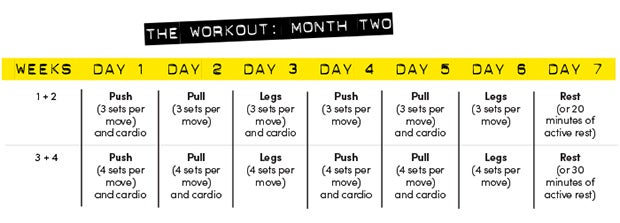
Dumbbell Chest Press
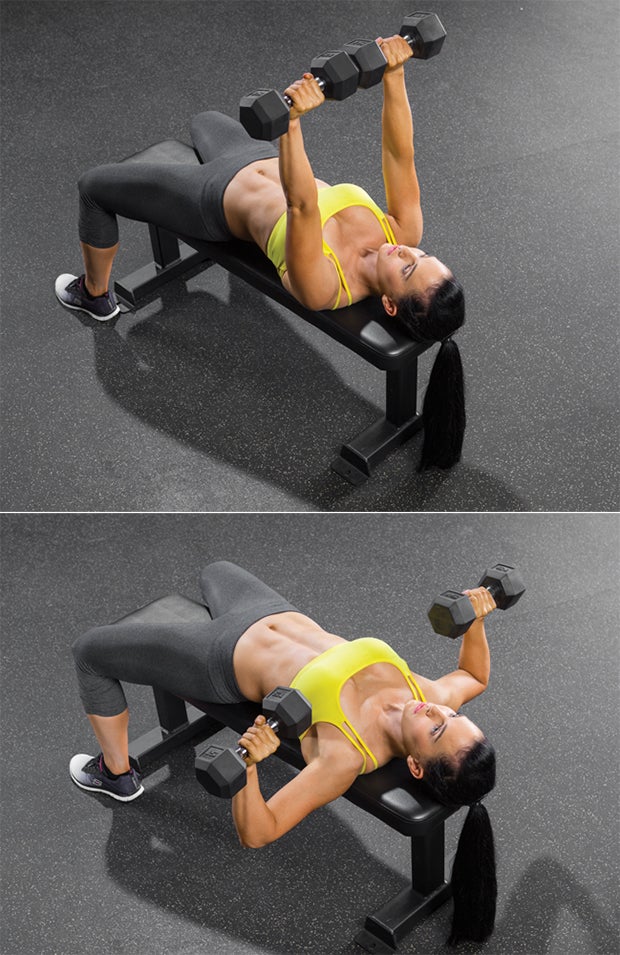
Muscles targeted: chest, shoulders and triceps
Setup: Lie on a flat bench with your feet flat on the floor. Grab a dumbbell in each hand and press them up above your chest, palms facing forward.
Move: Keeping your back flat on the bench, lower the dumbbells down to the sides of your chest. Pause, press the weights back up until your arms are fully extended above your chest, elbows unlocked, and repeat.
Ramp it up by … flexing your chest muscles at the top, pausing when the weights are halfway down and/or lowering one arm at a time.
Dial it down by … choosing a lighter weight, then alternate between doing a chest press and a chest flye.
Tip: Don’t arch your back — your torso should remain flat on the bench.
Dumbbell Push Press
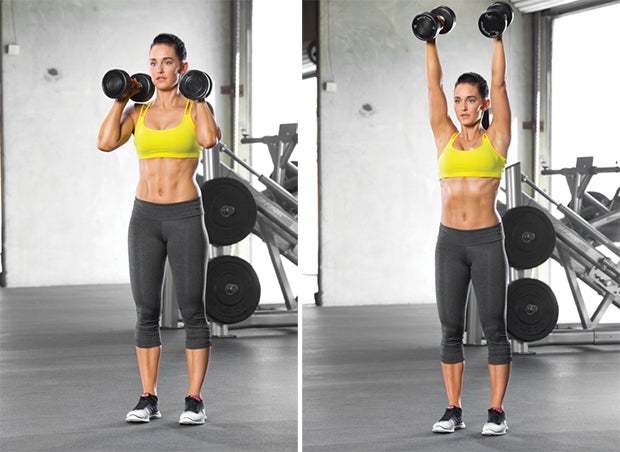
Muscles targeted: shoulders, triceps, upper trapezius (plus legs and core)
Setup: With your feet shoulder-width apart, stand holding a heavy dumbbell in each hand in front of your shoulders with a semi-supinated grip (palms facing each other).
Move: Keeping your back straight and eyes looking forward, squat down about 6 inches, look up, then explosively push up with your legs as you push the dumbbells straight above your shoulders. Lower the dumbbells back down to the setup position and repeat.
Ramp it up by … squatting down even farther than 6 inches (up to having your thighs parallel to the floor).
Dial it down by … resting a few seconds between reps.
Tip: Keep your heels flat on the floor and focus on pushing through them as you press.
Overhead Dumbbell Triceps Extension
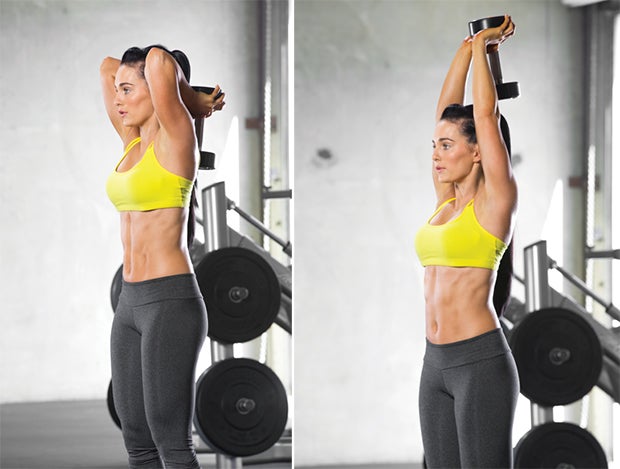
Muscles targeted: triceps
Setup: Stand straight, feet shoulder-width apart, holding a heavy dumbbell in both hands. Push the dumbbell over your head and hold it so that either both hands wrap around its middle or so that your palms are flat against the inside plate — one end of the dumbbell should be pointing up while the other end will be pointing down toward your head.
Move: Without moving your upper arms, slowly bend your elbows and lower the dumbbell behind your head as far as possible. Push the dumbbell back overhead until your arms are straight and repeat.
Ramp it up by … doing the exercise seated (which prevents you from using your legs to push the weight upward), or hold two dumbbells instead (one in each hand, palms facing in and lower both behind your head either simultaneously or one at a time).
Dial it down by … not lowering the dumbbell(s) as far down.
Tip: Keep your upper arms stationary — if your elbows move either forward or backward, you’ll rob your triceps of results while placing your shoulders at a greater risk of injury.
Medicine-Ball Press Crunch
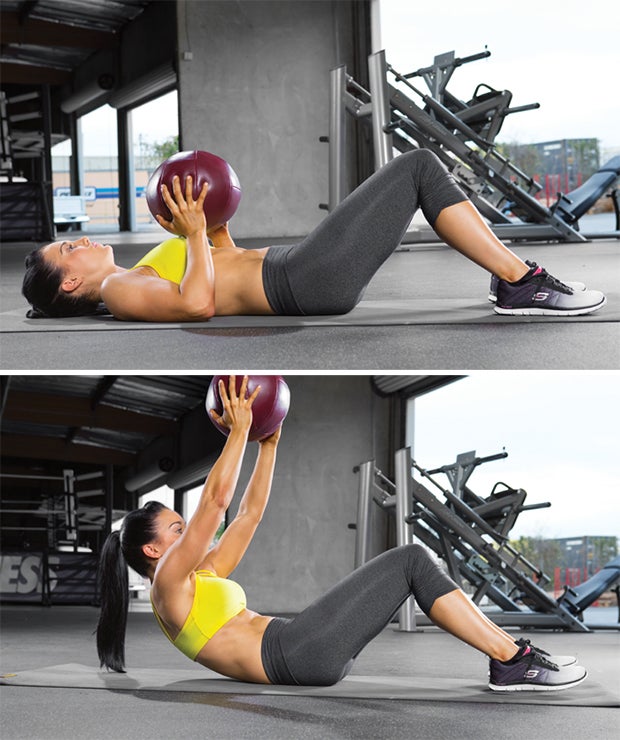
Muscles targeted: rectus abdominis (plus chest, shoulders and triceps)
Setup: Lie flat on your back on a mat with your knees bent and feet flat on the floor. Grab a medicine ball with both hands and rest it on your chest — your elbows should stick out to the sides.
Move: Slowly curl your head and shoulders off the floor about 4 to 6 inches toward your knees and simultaneously press the medicine ball up toward the ceiling. Lower back down to the setup position and repeat.
Ramp it up by … crunching first, then press the ball up — then lower it — before lowering your body back down to the floor.
Dial it down by …extending your arms up without holding a medicine ball.
Tip: Look forward as you crunch and resist staring at the ball — this can cause your head to tilt back, which can place stress on your neck.
Single-Arm Dumbbell Row
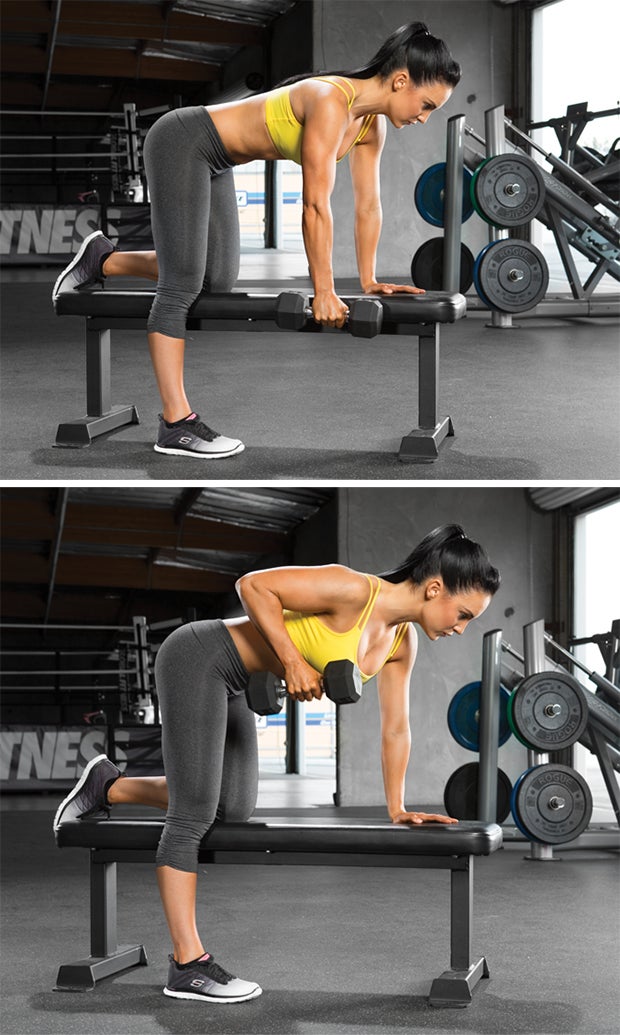
Muscles targeted: latissimus dorsi, lower back, biceps, trapezius and posterior deltoids
Setup: Stand at the side of a flat bench and a dumbbell in your right hand. Rest your left hand and knee on the bench, bend at the waist and let your right arm hang down toward the floor, palm facing in toward the bench.
Move: Draw the weight up close to the body until it reaches the side of your torso. Pause, lower the dumbbell back down until your arm is straight and repeat. After you’ve finished the required number of repetitions, switch positions to work your right arm.
Ramp it up by … pausing every time the dumbbell is halfway up or down.
Dial it down by … choosing a lighter weight. Focus on keeping your shoulders straight; no twisting as you rep.
Tip: Instead of pulling the dumbbell with your hand, focus on raising your elbow up to the ceiling.
Dumbbell Pullover
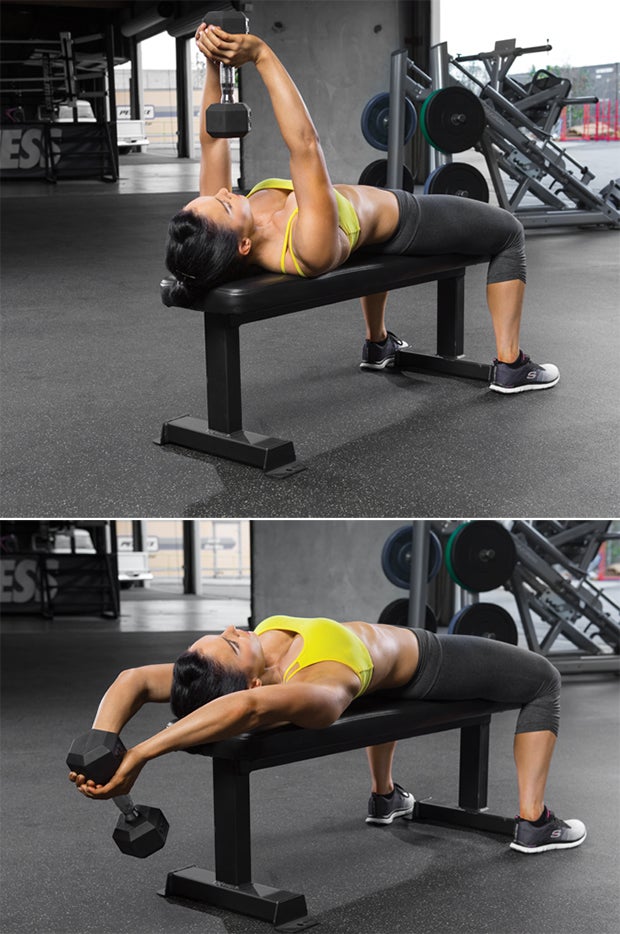
Muscles targeted: latissimus dorsi and middle trapezius
Setup: Grab a dumbbell and lie back on a flat bench with your feet flat on the floor. Shift yourself so that the top of your head is at the very end. Hold the dumbbell end over end on your chest, wrapping your thumbs and forefingers in a diamond shape right below the top bell. Press the weight over your chest, leaving your elbows slightly bent.
Move: Keeping your arms fixed in a slightly bent position, slowly lower the weight backward in an arc over your head until your upper arms are in line with your head. Pause, pull the weight back into the start position, then repeat.
Ramp it up by … holding two smaller dumbbells instead of one dumbbell and/or lower one dumbbell at a time (keeping your nonworking arm extended above your chest as you lower the other.)
Dial it down by … not lowering the weight as far down.
Tip: Don’t let your elbows bend or straighten as you perform the exercise — if they do, you’re cheating the weight up using your triceps muscles.
Cheat Curl
To do this exercise properly, grab a pair of dumbbells that are 20 to 30 percent heavier than you can usually handle for the required number of repetitions. For example, if you’re used to curling 15-pound dumbbells, then start the exercise with 20-pound dumbbells instead.

Muscles targeted: biceps
Setup: Stand holding a dumbbell in each hand, arms hanging down at your sides.
Move: Quickly curl the weights up, using your hips and shoulders to help lift the load. Pause at the top of the curl for one second, then slowly lower the weights back down for a count of four seconds. Repeat.
Ramp it up by … lowering the dumbbells for a count of five to six seconds and/or pause every time the weights are halfway down.
Dial it down by … taking three seconds to lower the dumbbells and/or using a weight that’s only 10 to 15 percent heavier than you typically curl.
Tip: Try to avoid raising your heels and coming up on your toes — this can cause you to lose your balance as you drive the weight upward.
Dumbbell Russian Twist
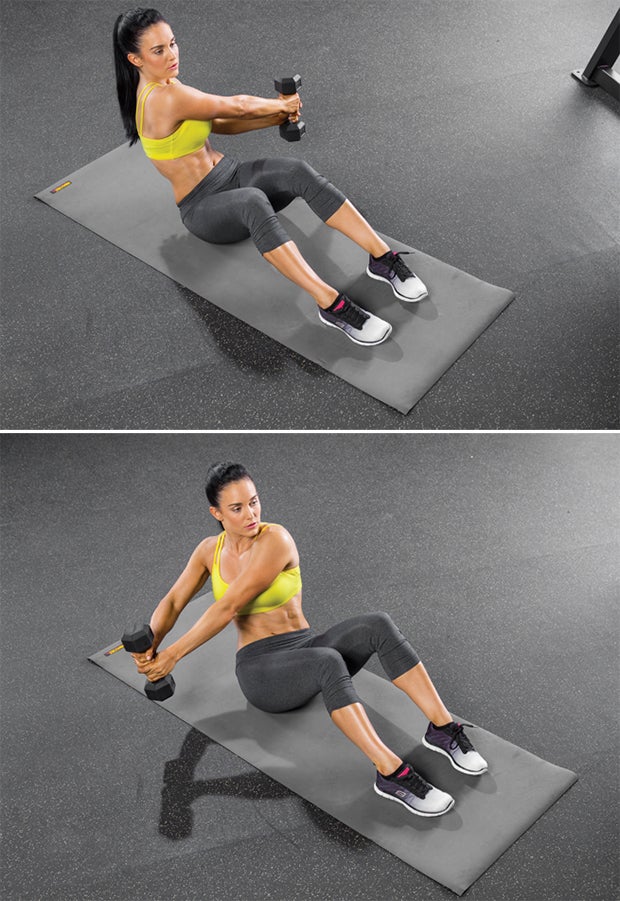
Muscles targeted: core and lower back
Setup: Sit down on a mat with your knees bent, feet flat on the floor holding a light dumbbell with both hands. Lean back until your torso is at a 45-degree angle, and extend your arms straight out in front of you, parallel to the floor.
Move: Keeping your core muscles tight, arms straight and feet on the floor, rotate your torso to the left as far as you can, then rotate to the right as far as possible. Continue to rotate your body from side to side throughout the exercise.
Ramp it up by … keeping your feet an inch off the floor throughout the entire exercise.
Dial it down by … sitting up farther than 45 degrees and/or not twisting as far.
Tip: You can move your torso only (as shown), but to maximize the benefits of this exercise, keep your eyes on the weight as you rotate.
Dumbbell Front Squat
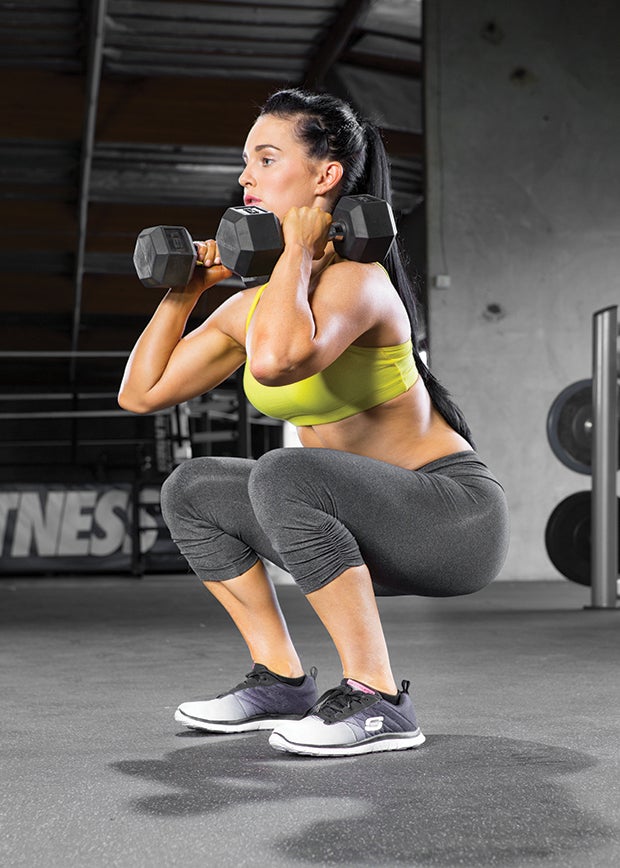
Muscles targeted: quadriceps, hamstrings, glutes, calves and core
Setup: Stand holding a dumbbell in each hand with your feet spaced hip-width apart. Curl both dumbbells and place the ends of each dumbbell on the front of your shoulders — your palms should face in toward each other, elbows pointing down.
Move: Keeping your torso straight, slowly bend your knees and squat down until your thighs are parallel to the floor. Stand back up until your legs are straight — knees unlocked — and repeat.
Ramp it up by … using one heavier dumbbell instead of two, then switching it from shoulder to shoulder after every rep.
Dial it down by … not squatting all the way down — either go halfway or a few inches shy of parallel.
Tip:Try draping the end of a towel over each shoulder for extra cushioning if having the dumbbells rest on you aches in any way.
Dumbbell Step-Up
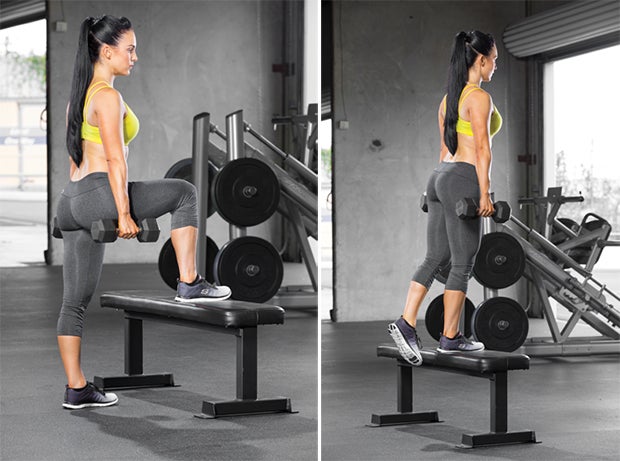
Muscles targeted: quadriceps, hamstrings, glutes and calves
Setup:Stand in front of the bench with your feet shoulder-width apart and a dumbbell in each hand. Your arms should be hanging down at your sides, palms facing in toward your legs.
Move: Keeping your back straight, place your right foot firmly on the bench and push yourself up (using only your right leg) until your left foot is able to step up on top of the bench — but don’t place your left foot on the bench. Pause, then take two seconds to lower your left foot back down to the ground so that it lands softly. Repeat for the required amount of reps, then do the exercise once more, this time by placing your left foot up on the bench.
Ramp it up by … raising the heel of whichever foot is on the bench as high as you can at the top of the move.
Dial it down by …bringing your lead foot off the bench after every rep. This will help you push off with your back leg, giving your forward working leg a break.
Tip: Make sure your lead foot is completely on the bench for stability — don’t let your heel hang off, even by an inch.
Dumbbell Farmer’s Walk
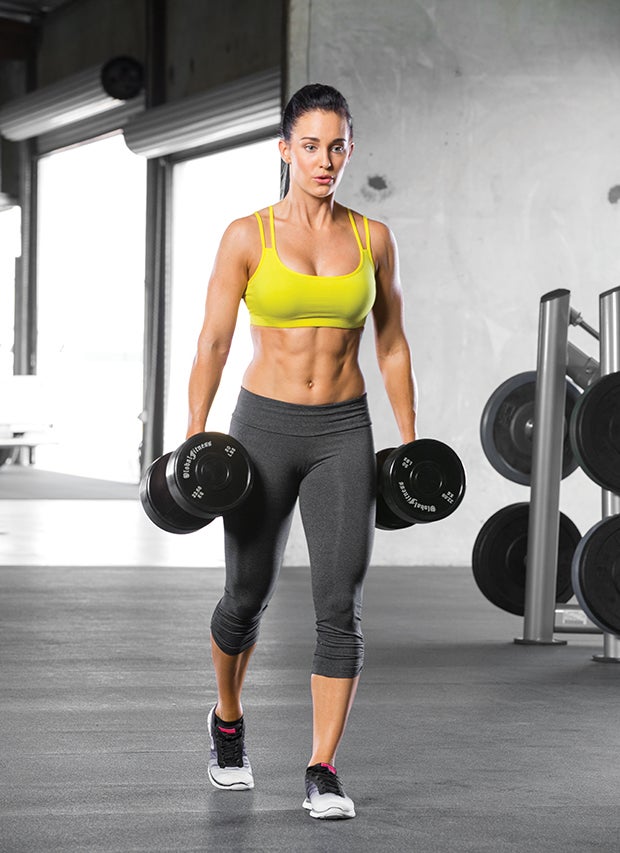
Muscles targeted: quadriceps, hamstrings, glutes and calves
Setup: Stand straight holding a heavy dumbbell in each hand, letting your arms hang down straight at your sides.
Move: Pushing off the balls of your feet, walk forward for the required length of time. If you lack enough space to walk around in, you also can walk in either a circle or in a figure-8 pattern.
Ramp it up by … increasing your speed as you walk, taking shorter, quicker steps.
Dial it down by …stopping every few seconds to take a one-second breather.
Tip: Don’t shrug your shoulders, which will exhaust your upper body before you thoroughly train your legs.
Dumbbell Romanian Deadlift
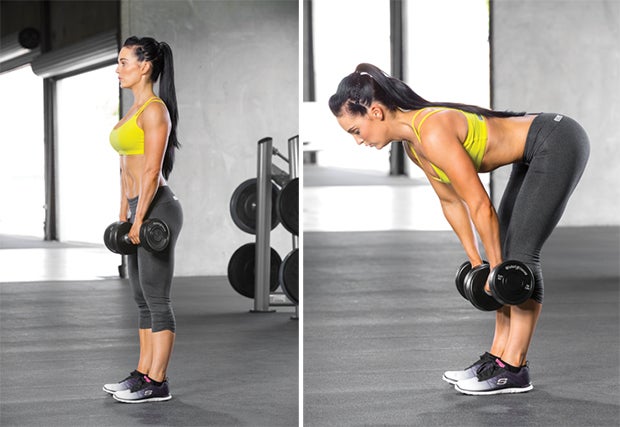
Muscles targeted: hamstrings and glutes
Setup: Stand holding a pair of dumbbells with an overhand grip — arms hanging down in front of your legs and your feet shoulder-width apart, knees slightly bent.
Move: Slowly push your hips back and lower the dumbbells just below your knees, keeping your head and chest up as you go. Return to the start position and repeat.
Ramp it up by … lifting one foot behind you an inch or two off the floor so that you’re balancing on the opposite foot.
Dial it down by … lowering the dumbbells an inch or two shy of reaching your knees.
Tip: Keep the dumbbells as close to your body as you can to target your hamstrings — or else your lower back will do most of the work.
Click HERE for Month 1.
Click HERE for Month 3.